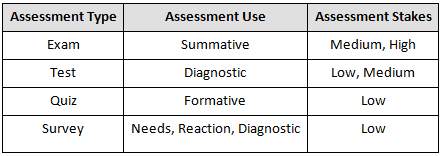Assessments have many different purposes, and to use them effectively it’s important to understand their context and uses within the learning process.
I’ll explore each of these five key assessment types over the next few weeks:
- Diagnostic
- Formative
- Needs
- Reaction
- Summative
Let’s start with diagnostic assessments.
TYPICAL USES:
- Identifying the needs and prior knowledge of participants for the purpose of directing them to the most appropriate learning experience
- Determining knowledge and identifying skills gaps and needs
- Placing learners in appropriate courses and tailor instruction to their needs
- Providing instructors and mentors information on a student’s abilities
- Giving feedback to participants and providing recommendations for products, services and/or learning activities
- Setting benchmarks for comparison with post-course tests
- Analyzing personality traits in order to predict behaviors
- Creating intrigue about the content of a learning activity, which can in turn actually enhance the learning experience
TYPES:
- Pre-tests
- Placement tests
- Self-diagnostic tools
- Personality assessments
Stakes: low/medium
Example: A diagnostic assessment might report that a learner has mastered every competency in using Microsoft Word but can only perform 50 percent of those required to use Excel. The results of the assessment would prescribe a course on Excel. In addition, a diagnostic assessment can help place students within suitable learning experiences by asking questions such as, “Do you prefer instructor-led training or online training?”

For a fuller analysis of assessments and their uses check out the white paper, Assessments Through the Learning Process. You can download it free here, after login. Another good source for testing and assessment terms is our glossary.
Tune in next week for a post on formative assessments.